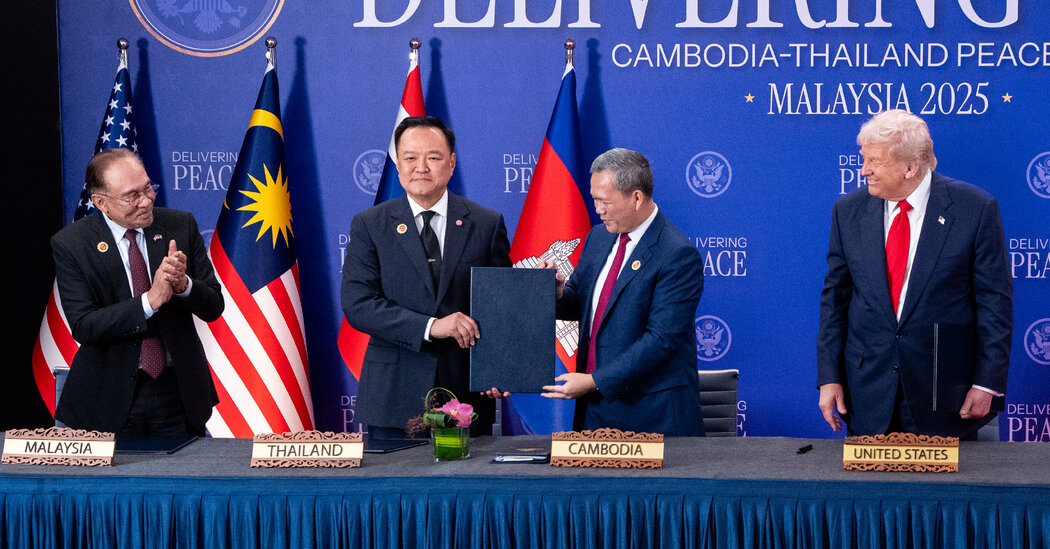Cambodia and Thailand on Sunday agreed to move toward resolving longstanding hostilities over their shared border, as President Trump took credit for mediating the decades-old dispute and sought once again to burnish his peacemaking credentials.
Mr. Trump and the prime minister of Malaysia, Anwar Ibrahim, helped broker a cease-fire between Cambodia and Thailand in July, ending a deadly five-day conflict. On Sunday they witnessed Prime Minister Hun Manet of Cambodia and his Thai counterpart, Anutin Charnvirakul, sign an agreement in Kuala Lumpur, the Malaysian capital.
It was the one of the most high-profile commitments toward peace between the two sides. Mr. Trump termed the deal “the Kuala Lumpur peace accords” and called it “historic.”
But there are significant obstacles for lasting peace: the neighbors have not agreed how to define the border and have to manage nationalistic emotions over the issue. The official text of the agreement described it not as a peace deal but a joint declaration by the prime ministers of both Cambodia and Thailand “on the outcomes of their meeting in Kuala Lumpur, Malaysia.”
Still, a key part of the deal was a commitment by the two sides to withdraw heavy weapons from the border, moves that will be monitored by observers from the Association of Southeast Asian Nations. Another breakthrough was the announcement that Thailand would repatriate 18 prisoners of war to Cambodia.
The agreement on Sunday, signed during an ASEAN summit, was also remarkable because Thailand has consistently said it rejects third-party mediation in the dispute. Thailand’s foreign minister, Sihasak Phuangketkeow, told reporters that the United States helped in facilitating the talks but that the negotiations were bilateral.
At least 40 people were killed after the latest iteration of the border dispute erupted into war on July 24. Hundreds of thousands were displaced. Mr. Trump intervened on the third day of fighting, calling the leaders of both Thailand and Cambodia to say he was not going to continue tariff negotiations if they did not end the conflict.
On Sunday, Mr. Trump recounted the moment, saying he had been playing golf in Scotland when he made those calls.
“I said: ‘This is much more important than playing a round of golf, so we sat there all day long, making phone calls,’” Mr. Trump said. “And it was amazing, the way it came together very quickly.”
He added, “This is much more fun for me than anything” because “you’re saving people and saving countries.”
The pageantry of the signing was a leading factor in Mr. Trump’s attendance at this year’s ASEAN summit. He also signed trade agreements with Cambodia, Thailand and Malaysia on Sunday.
Mr. Hun Manet reminded Mr. Trump that Cambodia had nominated him for the Nobel Peace Prize, an accolade Mr. Trump covets. He said he wanted to express his deepest gratitude for Mr. Trump’s “decisive leadership and steadfast commitment to supporting the lasting peace between Cambodia and Thailand.”
Mr. Hun Manet said that military commanders from Cambodia and Thailand were discussing the first phase of the withdrawal of heavy weapons from the border. He said that it was an indication of Cambodia’s willingness to execute the joint declaration.
Mr. Anutin also credited Mr. Trump for his “personal dedication to peace between our two countries.”
“This declaration, if fully implemented, will provide the building blocks for a lasting peace, but more important, it will begin the process of mending our ties,” Mr. Anutin said.
Mr. Trump repeatedly credited himself for his work in the peace process, reiterating that this was “one of eight wars that my administration has ended in just eight months.” He criticized the United Nations for what he deemed inaction over this summer’s fighting.
But despite the cease-fire, tensions at the border have been simmering.
Thailand and Cambodia have clashed over their roughly 500-mile border for more than half a century. The dispute stems from a 1907 map created during French colonial rule in Cambodia. Cambodia still uses that map; Thailand says it is inaccurate and uses a map that it says is more reflective of the border because it uses modern topography.
Sui-Lee Wee is the Southeast Asia bureau chief for The Times, overseeing coverage of 11 countries in the region.
The post Under Trump’s Aegis, Cambodia and Thailand Agree to Resolve Border Dispute appeared first on New York Times.




